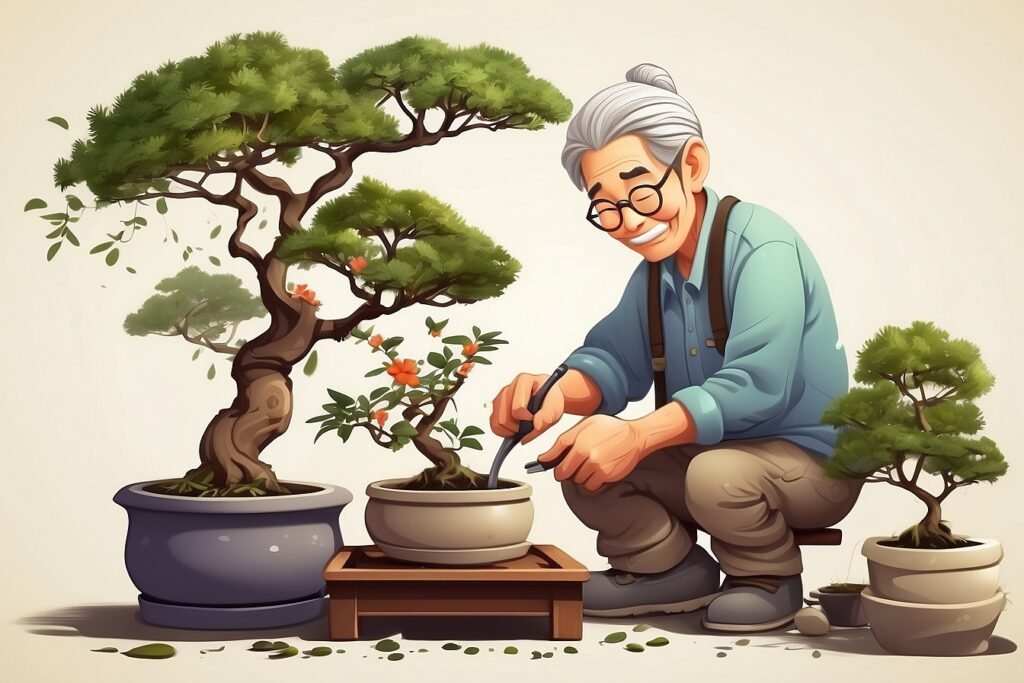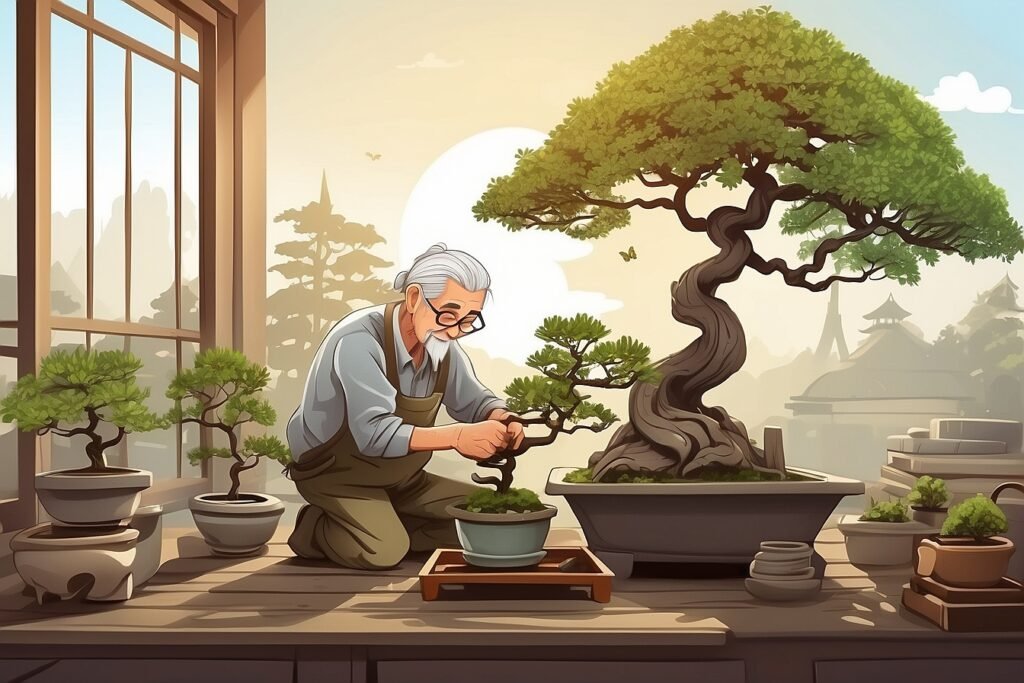Introduction
Did you know the Mugo Pine Bonsai is trendy among bonsai enthusiasts? This evergreen dwarf tree has lovely dark green needles and dense branching that make it stand out. It’s originally from the mountainous regions of Central and Southern Europe and is also known as the Mountain Pine. It grows slowly, but indeed, it’s just so cute and charming!

If you’re thinking of growing a bonsai with a Mugo Pine, it’s best to go for the plain variety rather than its different types. While you might find the rock-garden varieties like P. mugo ”Mops” and ”Valley Cushion” cute, they tend to be more delicate regarding bonsai cultivation. You should be able to find plain Mugo Pines easily at garden centers and nurseries.
| Species | Native Region | Distinctive Features |
|---|---|---|
| Mugo Pine (Pinus mugo) | Central and Southern Europe | Dark green needles, dense branches, slow growth rate |
| Japanese Black Pine (Pinus thunbergii) | East Asia | Black bark, needle-like leaves |
| Scots Pine (Pinus sylvestris) | Europe and Asia | Red-brown bark, blue-green leaves |
Understanding Mugo Pine Bonsai
One of the things that makes the Mugo Pine Bonsai stand out is its compact growth habit. Its bushy, dense branches and short, dark green needles give it a visually appealing and textured look, making it perfect for creating miniature landscapes in a bonsai tray.
Before you start cultivating your Mugo Pine Bonsai, it’s essential to know that you should use the plain Mugo Pine variety for bonsai cultivation. Some varieties, such as ‘Mops’ and ‘Valley Cushion,’ must be more responsive to bonsai cultivation techniques.
The Ideal Environment for Mugo Pine Bonsai
These trees need plenty of light to grow their best, and nothing beats the natural light they receive in an outdoor setting. Plus, they benefit from the changes in weather and temperature that come with each season. Being outside also gives them the space to grow their characteristic dense branches, which is super important for their development.
Now, when it comes to winter, don’t worry too much about your Mugo Pine. These hardy trees are adaptable and can fight cool to cold temperatures without any issues. Cold temperatures help trigger their dormancy period, a rest phase that allows the tree to conserve energy and prepare for spring growth.
That being said, if you live in an area with extremely harsh winters, protecting your Mugo Pine from severe freezes might be a good idea. You can move it to a sheltered location or use a protective cover.
Here’s a handy table with the ideal environmental conditions for a Mugo Pine Bonsai. I hope this helps!
| Environmental Factor | Ideal Condition |
|---|---|
| Placement | Outdoors |
| Light | Ample sunlight |
| Temperature | Cool to cold winters, temperate summers |
| Protection | Sheltered during extreme winter conditions |
How to Report your Mugo Pine
Repotting is essential to help refresh the soil, prevent rootbound conditions, and encourage healthy growth. But it must be done at the right time and with the proper technique to ensure your bonsai stays healthy and happy.

When is the Best Time to report Mugo Pine ?
This usually happens in two periods:
- Early Spring: Just before the new growth begins, usually around late winter or early spring, is an optimal time to repot your Mugo Pine Bonsai. This allows the tree to grow in fresh soil once the season starts.
- Late Summer: Another suitable period is after the first bloom of growth has extended and is cut back, usually around July and August in most climates. This timing corresponds to the tree’s natural growth cycle and ensures minimal disturbance.
How Often Should You Report Mugo Pine ?
The frequency of repotting your Mugo Pine Bonsai depends on its age:
- Young Specimens (2-3 years): Younger trees grow faster and, therefore, need repotting more frequently, typically every two to three years.
- Older Specimens (3-5 years): As the tree matures, its growth rate slows, and the frequency of repotting can be reduced to every three to five years.
Remember, repotting is not just about changing the soil; it’s also an opportunity to prune the roots and maintain the tree’s size and shape. However, it’s important to note that Mugo Pines can react poorly to excessive root pruning.
Therefore, if you’re repotting for the first time or the tree is in a weakened state, removing only about 50% of the old soil is advised, leaving the remainder for the next repotting.
Soil Requirements for Mugo Pine Bonsai

If you want to keep your Mugo Pine Bonsai healthy and blossoming, one crucial thing to remember is the soil it’s planted in. Specifically, you’ll want to ensure it has deep, well-drained soil.
Why is this so important, you ask?
For starters, it helps prevent waterlogging, which can be a real problem for Mugo Pines. These trees need a balance of moisture and air to grow properly, so well-drained soil ensures that water doesn’t just sit around the roots and cause issues like root rot.
But that’s not all. Good drainage promotes healthy root growth, which is essential for a strong and stable tree. And by fostering nutrient uptake, the right soil mix ensures that your bonsai gets all the nourishment it needs to thrive.
So, what kind of soil should you use?
There’s no one-size-fits-all answer, but a good mix for Mugo Pines typically consists of equal parts Akadama, pumice, and lava rock. This will give your tree the proper drainage, moisture, and nutrient balance.
Pruning and Wiring Mugo Pine Bonsai

Pruning and wiring are essential techniques that help shape your tree and promote healthy growth.
Pruning of Mugo Pine
When it comes to pruning, the best time to do it is in late spring or early summer, once the new growth has set off. This way, your bonsai will have enough time to recover before the next growth season. Start by removing any dead or dying branches to prevent diseases from spreading.
Then, cut back long or messy branches to maintain the tree’s shape and promote new growth. Remember to thin out the foliage to allow more light and air to reach the inner branches, keeping your bonsai healthy and vibran
Wiring of Mugo Pine
Wiring is another important technique that helps shape your bonsai and guide its growth direction. While young Mugo Pines can tolerate wiring during the summer, performing wiring in late summer or early autumn is usually recommended, aligning with other pine species. To wire your bonsai:
- Select the right size for the branch you’re shaping.
- The wire should be about one-third the diameter of the branch.
- Apply the wire to each branch, wrapping it around at a 45-degree angle.
- Make sure not to wrap it too tightly to avoid damaging the tree.
- Gently bend the branches into the desired shape, careful not to snap them.
Remember, pruning and wiring should be done thoughtfully, with a clear vision of your desired result. If you have any questions, feel free to ask!
Conclusion
When caring for your Mugo Pine Bonsai, remember to choose a plain Mugo Pine for bonsai cultivation, provide plenty of light and water, use slow-release fertilizer from Spring through to late Summer, report during active growth in the Summer, prune in late Spring or early Summer, and manage growth through techniques like bud selection and summer pruning. With patience, dedication, and the correct methods, you can cultivate a beautiful Mugo Pine Bonsai.
Further Reading and Resources
- Mastering the Art of Growing Bonsai Banana Trees: A Comprehensive Guide
- The Ultimate Guide to Nurturing Norway Spruce Bonsai
- The Quaking Aspen Bonsai: A Unique Artistry in Miniature Forestry
- Mastering the Art of Douglas Fir Bonsai: A Comprehensive Guide
- Exploring the Eastern Red Cedar as a Bonsai Choice
- The Revolutionary Practice of Hydroponic Bonsai: A Comprehensive Guide





